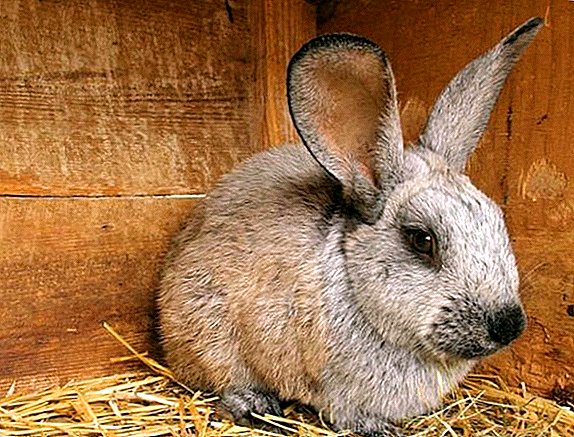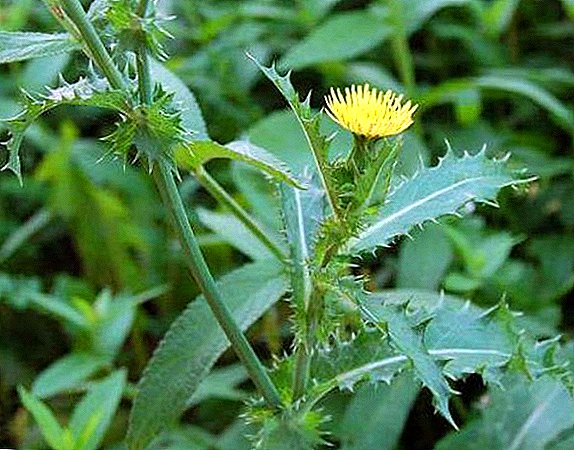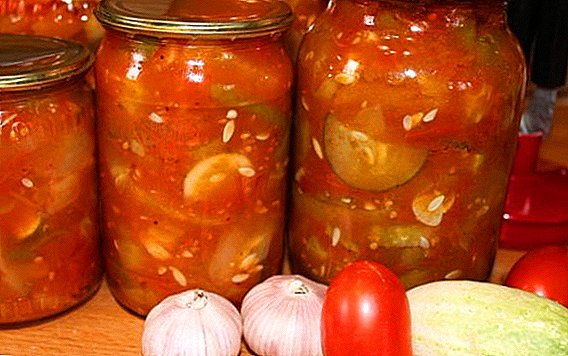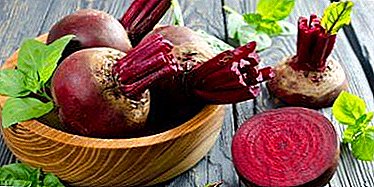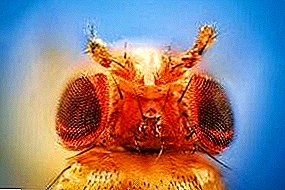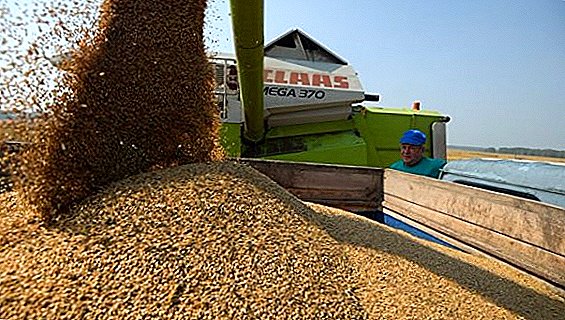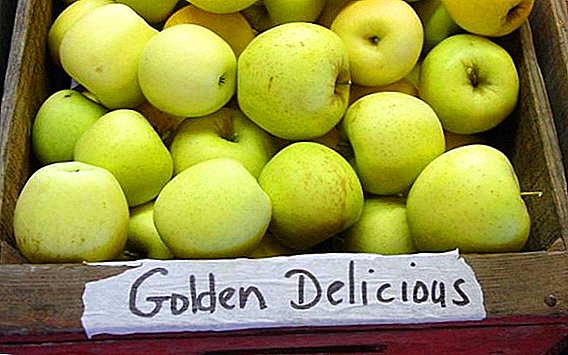 At present, a large number of exotic plants have begun to appear, which make it possible to make a flower garden, a terrace or a garden more unusual. So in our latitudes at sites began to grow Mexican sunflower, dichondra, penstemon and other plants. But one of the most unusual representatives of this group is Eucomis.
At present, a large number of exotic plants have begun to appear, which make it possible to make a flower garden, a terrace or a garden more unusual. So in our latitudes at sites began to grow Mexican sunflower, dichondra, penstemon and other plants. But one of the most unusual representatives of this group is Eucomis.
Botanical description
Unpretentious, heat-loving lily, which grows well in various regions of our country. A relative of the Asparagaceae family, pleasing us with its numerous inflorescences and extraordinary beauty.
Pineapple lily is a perennial bulbous plant, which in our latitudes are most often grown as a houseplant or garden plant. It is considered to be a herbaceous plant. It grows up to 1 meter in height. The bulbs of this exotic flower are rather large (from 5 to 8 cm in diameter), have an ovoid shape with a strong root system. The root system is developing very quickly, which should be considered when planting this flower, especially if you use a pot or pot.
Important! To grow Eucomis as a houseplant, you must use a pot with holes and do not forget about the drainage. If you do not adhere to these requirements, there is a stagnation of moisture, which can lead to rotting of the bulb.
The leaves grow from the bulb and have a ribbon-like shape. They are collected in the rosette. To the touch rather soft and pleasant. Some leaves have dark brown spots. The length of the leaves can reach 60 cm.  With the onset of summer in the center of the bulb begins to form a powerful arrow of the peduncle, which has a cylindrical shape. Such a stem can reach 1 meter in height. On it densely located inflorescences with flowers in the form of stars are formed. Buds can vary in color from white, cream to purple or lilac. In some varieties of inflorescences can combine different shades.
With the onset of summer in the center of the bulb begins to form a powerful arrow of the peduncle, which has a cylindrical shape. Such a stem can reach 1 meter in height. On it densely located inflorescences with flowers in the form of stars are formed. Buds can vary in color from white, cream to purple or lilac. In some varieties of inflorescences can combine different shades.
Familiarize yourself with the cultivation of other bulb flowers: tulips, hyacinths, lilies, daffodils, poultice, allium, crocuses, autumn crocus, gladioli.
On top of the peduncle, a cap is formed of green bracts that resemble leaves. It is this peculiarity of the flower that gave it the second name "Pineapple Lily". The period of abundant flowering of Eucomis falls on June-July. However, there are rare species that are able to bloom until early September.
When the inflorescence is fading, a round trihedral ovary is formed, where seed boxes are formed. Seeds are black or dark brown. They are collected for further reproduction of Eucomis. If you create favorable conditions and properly plant a pineapple lily from seeds, then after 3 years you can enjoy beautiful flowers. 
Distribution and habitat
Eukomis homeland is the southern part of Africa. This flower came to Europe only in 1788. It was this year that he received his scientific name from botanist Charles-Louis Periere de Bruthel. The name "Eucomis" or "Eucomis" in translation from ancient Greek means "beautiful whirlwind" or "beautiful-haired." In the people, this flower is better known as the "pineapple lily" or "the cholee lily".
Did you know? Evcomis is not rarely attributed to both the Asparagus family and the Liliev family (or even to Hyacinths).
 The most widespread Eucomis received in southern Africa, as well as in the tropical and subtropical forests of South America. In our country, it grows well in open ground and in a pot. However, the tuft lily cannot spend the winter in the open field; therefore, it is necessary to replant it in a pot every autumn, and plant it back in the spring.
The most widespread Eucomis received in southern Africa, as well as in the tropical and subtropical forests of South America. In our country, it grows well in open ground and in a pot. However, the tuft lily cannot spend the winter in the open field; therefore, it is necessary to replant it in a pot every autumn, and plant it back in the spring.
Popular types of Eucomis
This flower has 14 varieties and hybrids. Of these, the most common are:
- dotted (punctata) is the most famous representative of this culture. In height, it grows up to 1.5 meters, a large variety of flowers are collected on a green-tinted cyst. In the lower part of the leaves are covered with dotted patches, and their shape is linear;
- redbody (purpureicaulis) - This variety has spatulate leaves, stem red or purple. The same coloring of the flowers, but they are green;
- undulata - its inflorescences are most similar to pineapple fruit, it has long foliage with a belt-like shape. In the inflorescence can be collected about 50 flowers with many green flowers;
- autumn (autumnalis) - one of the representatives of stunted pineapple lilies (up to 30 cm). The period of flowering in this variety is much later than that of other relatives (closer to the fall). Flowers are white, cream. A distinctive feature is also the ability to tolerate small frosts;
- bicolor has a great decoration. The arrow grows to 1.5 meters and is decorated with purple spots. Flowers also combine a greenish color with a purple edging;
- Pole Evans (Pole-evansii) - this variety stands out among its relatives with light green colors;
- crested (comosa) is one of the most popular species in our latitudes. It reaches 1 meter in height, and the length of the inflorescences is 30 cm. The flowers are 3 colorings: pink, purple and greenish. If you look at flowers from far away, then purple flowers are very similar to lilac;
- Sparkling Burgundy has flowers with a pink or burgundy color, and the leaves have a red tint.








Did you know? The most beautiful representative of Eucomis in the opinion of American botanists and gardeners is Eucomis pallidiflora. He even took his place of honor in the list of the most beautiful garden cultures of America.
Use in landscape design
The value of this culture is due to its beautiful and unusual colors, as well as an exotic look, which is able to decorate any area. Planting pineapple lily preferably in flowerpots or decorative pots. If planted in open ground, then it is necessary to take into account the peculiarities of wintering Eukomisa.
In landscape design it is better to use it as a single composition. Unusual and clear forms in combination with bright flowers and long flowering, can decorate a green lawn or give an original flower garden.  If Eucomis is used as a decorative ornament in a stone garden, then its bright green will help to emphasize the majestic beauty of the stones. This flower combines well with conifers or ground cover green plants. Most often it is combined with gerbera, alissum, lobelia or geyher.
If Eucomis is used as a decorative ornament in a stone garden, then its bright green will help to emphasize the majestic beauty of the stones. This flower combines well with conifers or ground cover green plants. Most often it is combined with gerbera, alissum, lobelia or geyher.
Learn how to design the landscape at the dacha.
Growing and caring for plants
In order to enjoy the beauty of pineapple lilies, you must pay special attention to the conditions of its content. After all, an exotic beauty is not adapted to our climatic conditions.
Conditions of detention
The bulb of the Khokholkov lily looks similar to gladiolus. In diameter, it is about 5-8 cm. The landing of Eucomis can begin in March or April. For planting use a pot or pot. Experienced gardeners recommend planting a single bulb in a container. In the southern regions of the country, the bulbs of this flower can be planted in open ground, but it is better to do this when the earth is well warmed, (in early May). When planting, the tip of the bulb should slightly rise above the soil.
Important! When growing Eucomis in room conditions, it is necessary to pick a sufficiently large pot or pot, since the root system of the plant develops very quickly.
From the bulb grows a rosette of leaves, and then there is a large and powerful flowering arrow. On it are formed inflorescences that are similar in appearance to pineapple. The inflorescence consists of many flowers in the form resembling stars. Flowers gradually bloom upwards. The color of the flowers depends on the variety of Eucomis. The flower-bearing arrow from above is crowned with the launch of bracts, which are often confused with leaves.  In the period of abundant flowering, the plant needs the sun, warmth and regular watering. Picking up a place for a cholera lily, it is better to choose a sunny place, but in extreme heat it needs a penumbra, which will protect it from the scorching sunny events. If you decide to grow a flower at home, then put it on the south window.
In the period of abundant flowering, the plant needs the sun, warmth and regular watering. Picking up a place for a cholera lily, it is better to choose a sunny place, but in extreme heat it needs a penumbra, which will protect it from the scorching sunny events. If you decide to grow a flower at home, then put it on the south window.
However, as a representative of exotic vegetation, Eukomis does not like drafts, so choose a place for him better in the lull. Also it is necessary to protect the pineapple lily from moisture.
You will probably be interested to learn about the most unusual colors of the world.
The flowering period of Eucomis lasts for 2-2.5 months. Most often, the period of abundant flowering falls in June-July. Bright greens gradually die off, but at the same time the plant does not lose its decorative appeal. On a long stalk ripen seed boxes. After seed ripening, the plant moves to the resting stage. When preparing a flower for wintering, seeds should be collected, the foliage should be cut, and the bulb should be dug out (if the plant sprouted in the open field) or put the pot into the room where Eucomis will be protected from the winter cold. The best way for wintering for Eucomis is a perforated package where there is no ground. If you leave the bulb in a pot at room temperature, the pineapple lily will also have a good rest period, while in March new sprouts and shoots will begin to appear.
The best way for wintering for Eucomis is a perforated package where there is no ground. If you leave the bulb in a pot at room temperature, the pineapple lily will also have a good rest period, while in March new sprouts and shoots will begin to appear.
On average, the life expectancy of Eucomis is 4-5 years.
Soil and fertilizer
The ideal soil is a mixture of woody soil, sand and humus. The ratio of all components of the mixture should be 1: 1. When the bulbs are transplanted into the soil, the ratio changes and makes up 3 parts of woody soil and 1 part of coarse sand and peat (or humus). Also allowed a mixture of land from the garden with sand in the ratio of 4: 1. Soil acidity should be 5.6-7.4 pH.
In the process of growth, an exotic beauty cannot do without fertilizer. It is necessary to start fertilizing Eukomis during the period of bud formation or after the appearance of the first seven leaves. Used feeding 1 time in 2 weeks. Fertilizers are made regularly throughout the flowering period.
Important! When using fertilizer for Eucomis, it is necessary to carefully select the fertilizer, since it does not tolerate nitrogen (may cause diseases of the bulb).
Watering and moisture
After planting the bulbs and until the first leaves appear, watering should be minimal. It gradually increases with the appearance of the flowering arrow. During the flowering period, Eucomis needs plenty of watering. In summer, the soil should be constantly wet. It is necessary to water only with warm water (not from a well).  When the pineapple lily ceases to bloom, watering is reduced, and in September it stops altogether. Watering should also stop with the appearance of yellowing leaves. This is the first stage of preparation for hibernation.
When the pineapple lily ceases to bloom, watering is reduced, and in September it stops altogether. Watering should also stop with the appearance of yellowing leaves. This is the first stage of preparation for hibernation.
Eucomis loves the increased air humidity (80%) or at least medium (50-70%). A pot with an exotic flower is better to put in a tray with wet clay. He is able to adapt to drier conditions, but he will not be so comfortable.
Relation to temperature
Evkomis loves warm weather and grows very well at temperatures from +20 to +25 degrees. In the process of wintering, it can tolerate temperatures well up to +5 degrees only if the flower bulb overwinters in a pot. If the bulb is pulled out of the ground, then during the rest period it should be in the refrigerator at a temperature of +10 degrees.
Flower reproduction
In the process of growth, Eukomis can multiply in two ways: from seeds and vegetatively. Let us consider these methods in more detail.
Seeds
This method of reproduction in the home almost no resort. It is only for breeding, besides, the pineapple lily will bloom for 3-4 years after planting. Seeds are picked by breeders after the end of the flowering period (in September).  After harvesting, the seeds are immediately sown in the nutrient soil, since during storage their probability of germination is significantly reduced. When growing Eucomis from seeds, it is possible to get a new flower, which will differ significantly from the mother plant. Caring for germinated seeds is the same as for an adult plant.
After harvesting, the seeds are immediately sown in the nutrient soil, since during storage their probability of germination is significantly reduced. When growing Eucomis from seeds, it is possible to get a new flower, which will differ significantly from the mother plant. Caring for germinated seeds is the same as for an adult plant.
Vegetative
The most common form of reproduction of the cholereum lily, since the probability of germination increases significantly and the plant will be the same as the flower donor. For the reproduction of Eucomis in the period of abundant growth, babies are formed on the bulb. However, it is better to separate the babies from the bulb during the resting period. With this method of reproduction all the features of the flower are saved.
Important! After separation of the processes from the parent bulb, sprinkle the place of separation with powdered powdered charcoal. This will protect the flower from fungal spores.
 The crested lily can also multiply by cuttings. To do this, separate the leaf from the base of the bulb. It is divided into parts of 5 cm. For growing use a pot. The resulting cuttings are stuck in a mixture of sand and peat to a depth of 2.5 cm.
The crested lily can also multiply by cuttings. To do this, separate the leaf from the base of the bulb. It is divided into parts of 5 cm. For growing use a pot. The resulting cuttings are stuck in a mixture of sand and peat to a depth of 2.5 cm.
A pot with cuttings is covered with a film and stored in a room with a temperature of +20 degrees, and the lighting should be diffused. Several times a week it is necessary to air and water the soil a little. Already after 2-2.5 months, an onion is formed at the base of the cutting. Such onions can be planted in separate containers.
Possible difficulties in growing
One of the problems that a gardener may face is the rotting of the bulb. To avoid such a fate can be with proper storage of Eukomika in the period of rest. In the spring and summer, it is necessary to follow the rules of watering, to avoid stagnant moisture.
Proper storage of an exotic flower in winter suggests it can be done in two ways. The first option involves overwintering the bulbs in a pot, which is stored at a low temperature (+ 5-10 degrees). In this case, any watering of the flower is excluded. The second method involves digging an onion from the ground. After which it is cleaned from dry roots. The bulb of Eucomis is stored in a refrigerator, using sand medium or a plastic bag.  Eukomis bulb after winter In the process of growing, gardeners may experience premature yellowing and dying green. This is due to an overabundance of moisture. If you notice that your pineapple lily begins to turn yellow early, then you need to reduce watering to a minimum. It is also worth digging an onion and inspect it for the presence of rot. When detecting rotten areas, they need to be removed.
Eukomis bulb after winter In the process of growing, gardeners may experience premature yellowing and dying green. This is due to an overabundance of moisture. If you notice that your pineapple lily begins to turn yellow early, then you need to reduce watering to a minimum. It is also worth digging an onion and inspect it for the presence of rot. When detecting rotten areas, they need to be removed.
We advise you to find out how to grow exotic plants in the dacha: callistemon, booklet, hymenocallis, strelitzia.
Another nuisance in the process of growth of Eucomis may be associated with untimely flowering. If the period of flowering has come, and the plant has not released a flower-bearing arrow, then this can be explained by a low ambient temperature or a lack of lighting.
Pests, diseases and prevention
Eucomis is exposed to pests and various diseases. The main pests for this flower are spider mites, mealybugs, aphids and whiteflies. It is possible to get rid of such pests by processing with soapy water or by special means that are sold in flower shops.
The bulb may be subject to decay due to improper watering or non-compliance with storage conditions. Therefore, Eucomis needs proper care not only in the process of active growth, but also in the rest period.  Pineapple lily is quite unpretentious plant that can decorate any area. The use of Eucomis in landscape design allows you to emphasize the beauty of even the most unsightly piece of land. In our latitudes, an exotic flower does not need special care, which makes it possible to grow it even for a novice grower.
Pineapple lily is quite unpretentious plant that can decorate any area. The use of Eucomis in landscape design allows you to emphasize the beauty of even the most unsightly piece of land. In our latitudes, an exotic flower does not need special care, which makes it possible to grow it even for a novice grower.
Cultivation Reviews




